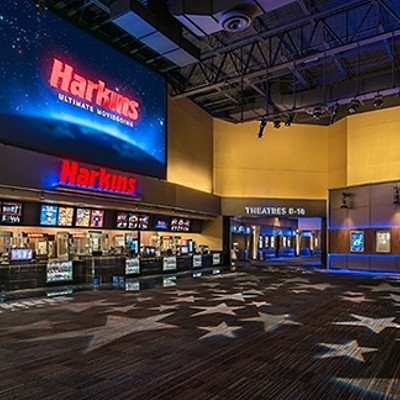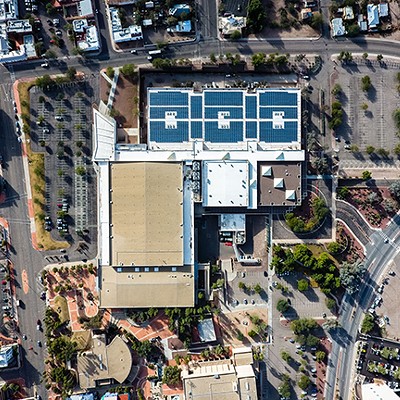In the distance, beyond the Santa Cruz River, he could see the little settlement, not yet a city, with its dusty streets and modest adobe houses. Just below, at the base of the hill, he could see the remains of the riverfront 18th-century Spanish "visita," or mission outpost. San Agustín's friars were long gone, but their unusual two-story adobe Convento was still standing, if starting to crumble.
The railroad had just arrived in Tucson, and Watkins waited to take his shot until he could see a train rolling through town. His exquisitely detailed photograph, preserved on a glass negative plate, today gives us some of the best information on what Tucson looked like before the railroad changed it forever.
More importantly, from the perspective of downtown's Rio Nuevo project, the photograph gives crucial details of the lost mission that once stood on the site known as Tucson's birthplace.
"Our reconstruction of the Convento is based on photography," said Marty McCune, the city's historic preservation officer and point person for the Tucson Origins Heritage Park.
An archaeological dig two years ago disappointingly turned up no traces whatsoever of the late, lamented Convento (see "Convento or 'Invento'," June 27, 2002), but planners believe photographs will fill in the gap. Along with the Watkins photograph, scores of 19th- and 20th-century photographs taken by ordinary Tucsonans have been added to a computer database run by a young archaeology whiz named Doug Gann. Architects will use Gann's virtual Convento to design a life-size 21st-century replica that looks as much as possible like the real deal
"What Doug Gann has done is unbelievable," McCune said. "We're confident we now have the backup."
Some opponents of the project, notably Bob Vint--the architect who has been shepherding the restoration of Mission San Xavier del Bac, the 18th-century mission southwest of town--argue that the evidence is far too sketchy for a full-scale restoration. But Diana Hadley, a historian on the planning team, echoed McCune.
"We have an ample number of photos to document the site," Hadley said.
Disagreements notwithstanding, the Tucson Origins planners are forging ahead with designs for a living history park at points on both sides of the desiccated Santa Cruz. At a public meeting from 4 to 7 p.m. next Wednesday, Oct. 22, at the Rio Nuevo office on 52 E. Congress St., residents can see--and comment on--a proposed park master plan put together by the team who got a city contract last March. The team will give a presentation at 5 p.m.
Led by that team, WLB, the planners are to deliver the final plan by Jan. 1. After that, the plan will wend its way through the long approval process, getting vetted first by two Rio Nuevo panels and then by the mayor and council.
Rio Nuevo, funded by a pot of public and project money that could hit $360 million, calls for a potpourri of projects meant to revitalize downtown over the next 10 years. Despite all the recent attention given its proposed Science Center, a two-part building that could straddle the riverbed via a pedestrian bridge, the Cultural Park is actually farther along, McCune said. The archaeology is mostly finished, and remediation of a landfill on the site is underway. Construction on its first phase could start in early 2005.
"This will be the cultural and historic heart of Rio Nuevo," said McCune. Before the Anglos came, the Santa Cruz was a real river, with perennial flows of water, and its banks were home to a succession of cultures over several millennia. A Rio Nuevo-funded dig two years ago discovered that farmers were cultivating the rich west bank floodplain as early as 4,000 years ago, far earlier than archaeologists had previously thought.
On the forlorn park site, south of Congress Street and west of Interstate 10, nowadays notable mostly for its weeds, the city plans to reconstruct the fabled Convento. (The city itself bulldozed its last remnants in the 1950s in order to make way for a landfill.) Also part of the package will be a reconstructed granary, mission gardens planted in historical flora, a facsimile of the 18th-century village used by Pima Indians who lived alongside the friars, Hohokam pithouses, and, in honor of the first farmers, a permanently protected archaeological excavation.
The idea is that the park will be a hands-on, kid-friendly place, where budding young archaeologists can get down and dirty in the dust and dig, or learn to make crafts, while imbibing lessons on their town's history.
"It will be a living park, not a museum," said Hadley, who emphasized that the park will be as much for Tucsonans as for visitors. Space will be designated for festivals and for crafts demonstrations. "We'll interpret an O'odham village, and we hope the O'odham people will help plan this. We'll have weaving, basket-making, pottery."
On the east side of the river, on a much smaller site that's now a parking lot at the corner of Washington Street and Church Avenue, Tucson Origins will rebuild a tower and a corner of the 18th-century presidio, a fort once manned by Spanish battalions safeguarding the northernmost frontier of New Spain. An adjoining triplex of 19th-century adobe houses is undergoing renovation under Vint's supervision; they may be used as headquarters or exhibition space.
"We don't have the same kind of information on the Presidio," McCune said. "That was before photography. ... We don't have a lot of records; we do have archaeology and some written accounts. It's a little more conjectural."
That kind of conjecture is partly what infuriates opponents of the plan to make new "old" buildings. Like Vint, scholar R. Brooks Jeffery, head of the UA's preservation program, is an expert on historic Tucson architecture, and like Vint, he has written an article criticizing the plan. As a historic preservation pro, McCune knows as well as anybody that preservationists often view such enterprises as pieces of Disneyesque fantasy.
The two-story adobe Convento, for instance, will have to be up to 21st-century code, reinforced with modern materials. In essence, critics say, it will be a faux-antique skin on a contemporary skeleton.
"It's legitimately controversial," McCune acknowledged. "But the deal is, if you have enough evidence, you can reconstruct."
Vint believes that it's foolish to make a fake 18th-century mission when the city already has a glorious--and real--one in the form of San Xavier. He worries that visitors will mistake the facsimile Convento for an authentic building. Most importantly, he says, the photographic evidence just isn't adequate.
"Nothing approaching 'sufficient historical documentation' exists regarding the Mission and Convento," he wrote in the Revista, the newsletter of the Southwestern Mission Research Center at the Arizona State Museum. "The reconstructions would be largely conjectural. ... We have only very sketchy ideas of floor plans and wall heights, not to mention such architectural features as windows, doors, decorative details and finishes. ... The immortal words of Gertrude Stein come to mind, 'There's no there there.'"
Vint did join another team that was short-listed for the project, led by Jones & Jones of Seattle. But Vint favored possibly doing just an adobe outline of the Convento on the ground, or even forgetting about it altogether and building a plaza instead, perhaps with housing or a community center around it. McCune headed the selection committee, and she said that while the Jones team came up with a good plan, they were "less definite about the reconstruction issue."
And a replica Convento is what the people want, she said. The original 1999 ballot proposal for Rio Nuevo, passed by the voters, called for rebuilding, and so did the city's request for proposals. The westside neighbors have also clamored for a re-created Convento. The winning team had no problem complying.
"We are absolutely going to do a full-scale reconstruction of the Convento," said Mike Byrne, of WLB. "It's one thing just to lay bricks in the ground, another to step into an adobe building. We are going to step back in time and be accurate."
Both sides can agree that Tucson should never have allowed such a significant building to crumble into dust. Accordingly, the Convento park will include a station called "lessons learned." It will detail Tucson's sad history of obliterating its historic past, from its Convento to its presidio to its oldest barrio.
As Hadley put it, "It would have been much, much cheaper to replaster this building and save it a long time ago. That's one of the lessons of the site."
















